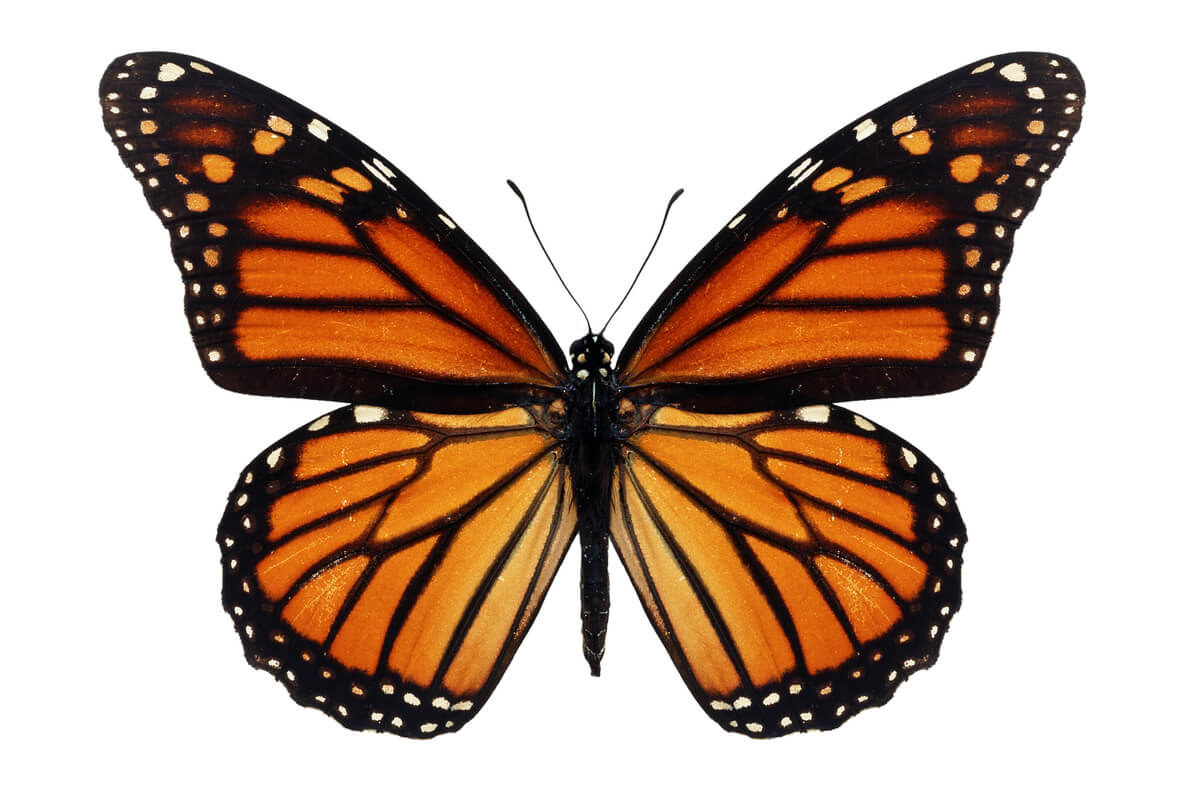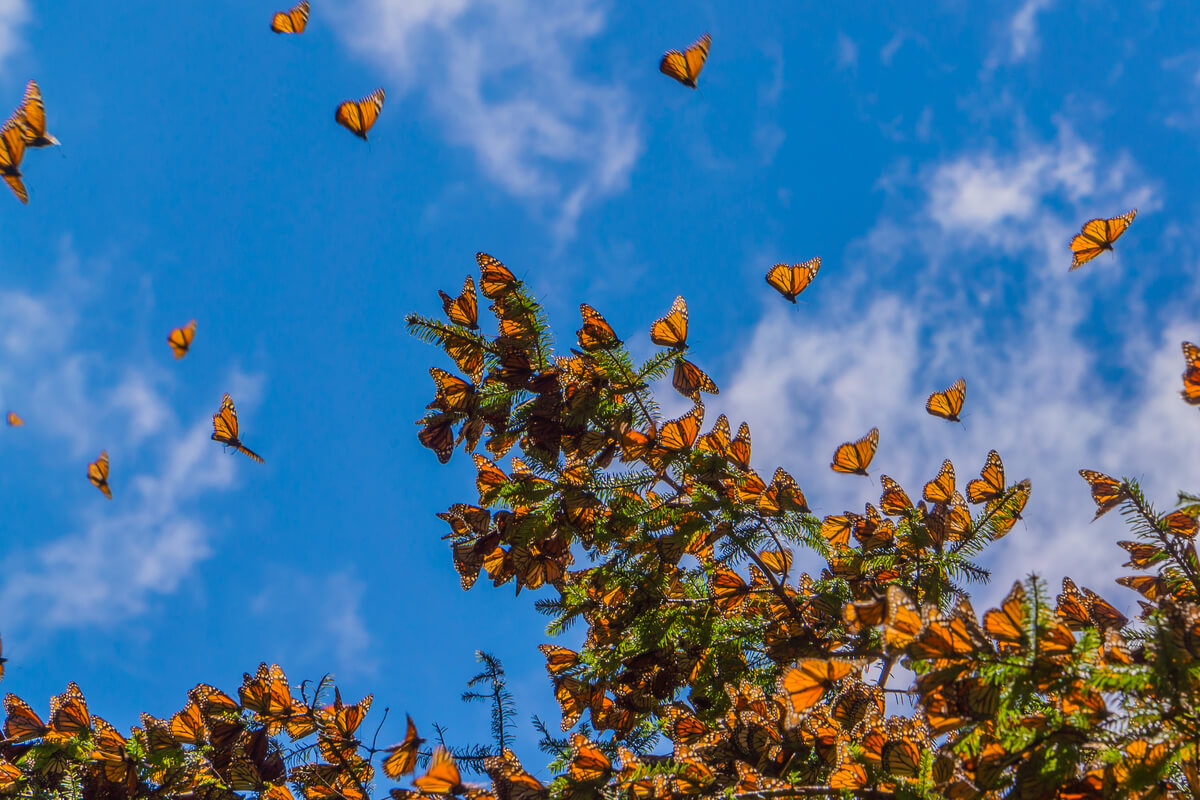The Monarch Butterfly Is in Danger of Extinction


Written and verified by the biologist Francisco Morata Carramolino
The monarch butterfly is one of the Lepidopterans and one of the best-known insects in the world. With its iconic orange and black appearance and migratory odyssey, this invertebrate has won our hearts. In the USA, it has become a symbol of the passing of the seasons and is part of important cultural traditions.
However, the butterfly isn’t going through its best time. Certain human actions threaten their existence and reduce their populations. If we’re not careful, the planet could lose this fantastic animal. If you want to learn more about the monarch butterfly, its conservation status, and its threats, we invite you to continue reading.
Monarch butterfly characteristics
The monarch butterfly, with the scientific name Danaus plexippus, is a lepidopteran of the Nymphalidae family. This invertebrate is easily recognizable thanks to its two pairs of wings, which give it a wingspan of between 7 and 10 centimeters (3-4 inches).
The wings are deep orange. They are bordered by wide black margins and traversed by a series of finer black veins. The margins are adorned with a series of white dots. The rest of the body is also black and features some of these color patterns.
The wing veins are finer in males than in females. These also feature a black dot running through one of the veins on each rear wing.
One of the most striking characteristics of these insects is their incredible migratory journey, which crosses entire continents and requires several successive generations of butterflies to complete. Danaus plexippus is the only known butterfly that performs this type of migration .

Why is the monarch butterfly in danger?
These Lepidoptera used to be incredibly abundant. So much so that, during mass migrations, the sound of their flapping was reminiscent of the water of a stream or summer rain, according to the Center for Biological Biodiversity.
However, the total population of the monarch butterfly may have declined by around 90% since 1990. As is becoming increasingly common, this decline is mediated by human actions, which are often carried out without considering their impacts on the environment. Among the causes of this marked loss are the following:
Loss of habitat
The destruction of habitats is one of the most frequent and damaging threats to wild species. In the United States, much of the reproductive habitat of monarchs has been eliminated by modern agricultural practices, which are disastrous for the natural environment.
One of the most relevant problems is the disappearance of plants of the genus Asclepias, called milkweed in English. The monarch depends on these plants to survive, and they feed exclusively on them when they are larvae.
The expansion of modern agriculture and the systematic removal of vegetation on the edges of roads, highways and agricultural plots are responsible for the loss of milkweed and, therefore, of butterflies.
The wintering habitats of this species in Mexico are also being destroyed. The logging industry, both legal and illegal, is degrading the forests that butterflies use and causing deforestation. The expansion of the agricultural industry also contributes to this phenomenon.
Pesticides and GMOs
The use of herbicides is another of the widespread practices of modern agriculture that presents great problems for the conservation of species. These toxic chemicals, coupled with the use of transgenic crops that resist them, prevent the growth of Asclepias.
Pesticides are also very common in agriculture and garden management. Although they’re used to control insects considered harmful, they also harm butterflies and many other pollinating insects.
Some GM crops used today also contain toxins of bacterial origin, which can harm the monarch butterfly.
Climate change
Migratory animals are especially vulnerable to climate change. Their survival depends on their movements, which are regulated by specific environmental conditions.
As climate change alters environmental conditions, the coordination of migratory travel with optimal parameters could be lost. The ecosystems that this species needs could be lost or altered to the point of being unusable.
Butterflies may have to alter their migration routes to survive. It’s difficult to predict what will happen with climate change, but the future of this species doesn’t look very encouraging in the long term.
How to avoid the extinction of the monarch butterfly
To prevent the extinction of these insects, it’s essential to implement better management of agricultural lands, gardens, roadsides, and similar green spaces. This management should allow milkweed and other wildflowers that used to be very common to recover.
The mistakenly dubbed ‘weeds’ that we work so hard to eliminate are actually valuable native species. These plants and shrubs benefit biodiversity in general and pollinating insects in particular. Therefore, they are also very advantageous for people.

The protection of the areas that these lepidopterans use against the excessive advance of the industries is also of undeniable importance. We need to support robust environmental policies that minimize the emission of polluting gases and slow down climate change.
All cited sources were thoroughly reviewed by our team to ensure their quality, reliability, currency, and validity. The bibliography of this article was considered reliable and of academic or scientific accuracy.
- https://www.nwf.org/Educational-Resources/Wildlife-Guide/Invertebrates/Monarch-Butterfly
- https://monarchjointventure.org/monarch-biology/threats
- https://www.nationalgeographic.com/animals/article/monarch-butterflies-risk-extinction-climate-change
- https://www.nationalgeographic.com/animals/invertebrates/facts/monarch-butterfly
- https://www.worldwildlife.org/species/monarch-butterfly
- Wilcox, A. A., Flockhart, D. T., Newman, A. E., & Norris, D. R. (2019). An evaluation of studies on the potential threats contributing to the decline of eastern migratory North American monarch butterflies (Danaus plexippus). Frontiers in Ecology and Evolution, 7: 99.
This text is provided for informational purposes only and does not replace consultation with a professional. If in doubt, consult your specialist.